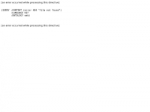
Chatbot listing, virtual agents, virtual assistants, chat bot directory, conversational agents, virtual human news, chatterbot list
NEWS: Chatbots.org survey on 3000 US and UK consumers shows it is time for chatbot integration in customer service!read more..
An Introduction to Software Agents
 Since the beginning of recorded history, people have been fascinated with the idea of non-human agencies. Popular notions about androids, humanoids, robots, cyborgs, and science fiction creatures permeate our culture, forming the unconscious backdrop against which software agents are perceived. The word “robot,” derived from the Czech word for drudgery, became popular following Karel Capek’s 1921 play RUR: Rossum Universal Robots. While Capek’s robots were factory workers, the public has also at times embraced the romantic dream of robots as "digital butlers" who, like the mechanical maid in the animated feature "The Jetsons", would someday putter about the living room performing mundane household tasks. Despite such innocuous beginnings, the dominant public image of artificially intelligent embodied creatures often has been more a nightmare than a dream. Would the awesome power of robots reverse the master-slave relationship with humans? Everyday experiences of computer users with the mysteries of ordinary software, riddled with annoying bugs, incomprehensible features, and dangerous viruses reinforce the fear that the software powering autonomous creatures would pose even more problems. The more intelligent the robot, the more capable of pursuing its own self-interest rather than its master’s. The more humanlike the robot, the more likely to exhibit human frailties and eccentricities. Such latent concerns cannot be ignored in the design of software agents-indeed, there is more than a grain of truth in each of them!
Since the beginning of recorded history, people have been fascinated with the idea of non-human agencies. Popular notions about androids, humanoids, robots, cyborgs, and science fiction creatures permeate our culture, forming the unconscious backdrop against which software agents are perceived. The word “robot,” derived from the Czech word for drudgery, became popular following Karel Capek’s 1921 play RUR: Rossum Universal Robots. While Capek’s robots were factory workers, the public has also at times embraced the romantic dream of robots as "digital butlers" who, like the mechanical maid in the animated feature "The Jetsons", would someday putter about the living room performing mundane household tasks. Despite such innocuous beginnings, the dominant public image of artificially intelligent embodied creatures often has been more a nightmare than a dream. Would the awesome power of robots reverse the master-slave relationship with humans? Everyday experiences of computer users with the mysteries of ordinary software, riddled with annoying bugs, incomprehensible features, and dangerous viruses reinforce the fear that the software powering autonomous creatures would pose even more problems. The more intelligent the robot, the more capable of pursuing its own self-interest rather than its master’s. The more humanlike the robot, the more likely to exhibit human frailties and eccentricities. Such latent concerns cannot be ignored in the design of software agents-indeed, there is more than a grain of truth in each of them!
New Comment
Only registered members are allowed to comment. or login
or login
